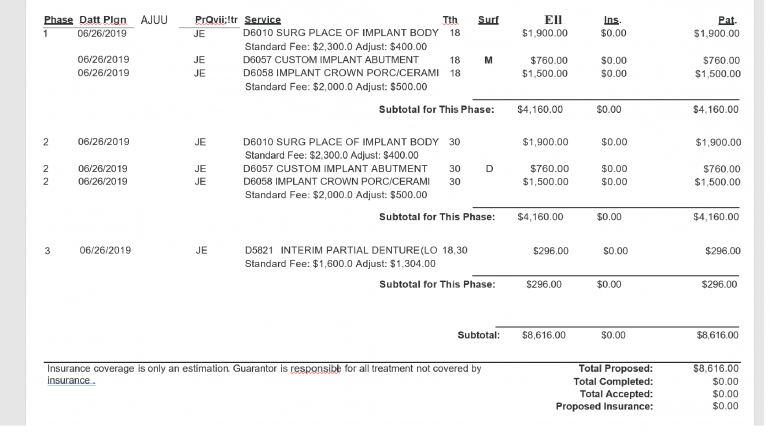
Dental Code D5212: Mandibular partial denture – resin base (including, retentive/clasping materials, rests, and teeth)
Dental Code D5212 refers to a specific dental procedure known as a mandibular partial denture with a resin base. This code encompasses the entire process of fabricating a custom-made denture for the lower jaw, including the use of retentive/clasping materials, rests, and artificial teeth.
Dental Code D5212: Price Ranges & Savings
As with other services, prices in America vary from dentist to dentist and city to city. The minimum charge for this service is $800 and the maximum $2200. Most dentists charge around $1300.
Low cost of living | Medium cost of living | High cost of living |
Memphis (Tennessee), Cincinnati (Ohio) | Miami (Florida), Denver (Colorado), Austin (Texas) | (New York (New York), San Francisco (California) |
$800 | $1300 | $2200 |
Detailed information of the Procedure and Steps of Dental Code D5212: Initial Consultation and Evaluation
The first step in obtaining a mandibular partial denture involves an initial consultation and evaluation with the dentist. This appointment allows the dentist to assess the patient's oral health and determine if a partial denture is the appropriate treatment option. During the evaluation, the dentist will examine the condition of the patient's remaining natural teeth, the health of their gums, and the overall structure of their jaw. They may also take X-rays or impressions of the patient's mouth for further evaluation.
Designing the Framework
Once the dentist determines that a mandibular partial denture is suitable for the patient, the next step is to design the framework. The framework serves as the underlying structure of the denture, providing support and stability. It is typically made of a strong and lightweight material such as metal or resin, depending on the patient's specific needs and preferences. The design of the framework is customized to fit the patient's mouth precisely, ensuring a comfortable and secure fit.
Creating the Resin Base
After finalizing the framework design, the dental laboratory proceeds to create the resin base of the denture. The resin base is the part of the denture that rests against the patient's gums and holds the artificial teeth in place. It is made from a durable, lightweight, and biocompatible material, ensuring both comfort and functionality. The dental laboratory uses the impressions taken during the evaluation process to create a precise model of the patient's mouth, allowing for an accurate fit of the resin base.
Adding Retentive/Clasping Materials
Retentive/clasping materials play a crucial role in ensuring that the mandibular partial denture remains securely in place. These materials are strategically placed on the denture's framework and are designed to engage with the patient's remaining natural teeth. They provide retention and stability, preventing the denture from slipping or dislodging during daily activities such as eating or speaking. The retentive/clasping materials are carefully selected based on the patient's specific oral condition and needs, ensuring optimal performance and comfort.
Incorporating Rests
Rests are small metal or resin projections incorporated into the denture that provide support and stability by contacting the remaining natural teeth. These rests play a vital role in distributing the forces exerted during chewing, reducing the strain on the denture and the underlying oral structures. The dentist carefully positions the rests to optimize the denture's functional and structural integrity. They ensure that the rests make firm contact with the natural teeth but do not interfere with the patient's bite or cause any discomfort.
Adding Teeth
The final step in the D5212 procedure is the attachment of artificial teeth to the resin base. The dentist selects artificial teeth that closely resemble the patient's natural teeth in terms of size, shape, and color. These artificial teeth are securely attached to the resin base, creating a natural-looking and functional denture. The dentist makes any necessary adjustments to ensure proper occlusion (bite) and a comfortable fit. They also consider factors such as the patient's facial aesthetics and speech patterns to ensure the denture provides both cosmetic and functional benefits.
After the artificial teeth are securely attached to the resin base, the dentist evaluates the patient's bite alignment. They carefully assess the interaction between the upper and lower teeth to ensure proper occlusion, allowing for effective chewing and biting. Any necessary adjustments are made to achieve a balanced bite and a comfortable fit.
Summary of Dental Code D5212
Dental Code D5212 represents the process of fabricating a mandibular partial denture with a resin base, incorporating retentive/clasping materials, rests, and artificial teeth. This procedure involves an initial consultation and evaluation, the design and creation of the framework and resin base, the addition of retentive/clasping materials, the incorporation of rests, and the attachment of artificial teeth. Each step is meticulously carried out to provide a custom-made denture that fits the patient's mouth comfortably, restores function, and enhances their smile.
It is important to consult with a dentist to determine if a mandibular partial denture is the most suitable treatment option for specific dental needs. The dentist guides the patient through the entire process, considering factors such as their oral health, aesthetic preferences, and functional requirements. With the help of dental code D5212, individuals can regain their ability to eat, speak, and smile confidently, improving both their oral health and overall quality of life.
Dive into affordable dentistry with Dr. BestPrice! Assess options, choose wisely, and savor top-tier dental treatments without the premium expense.
